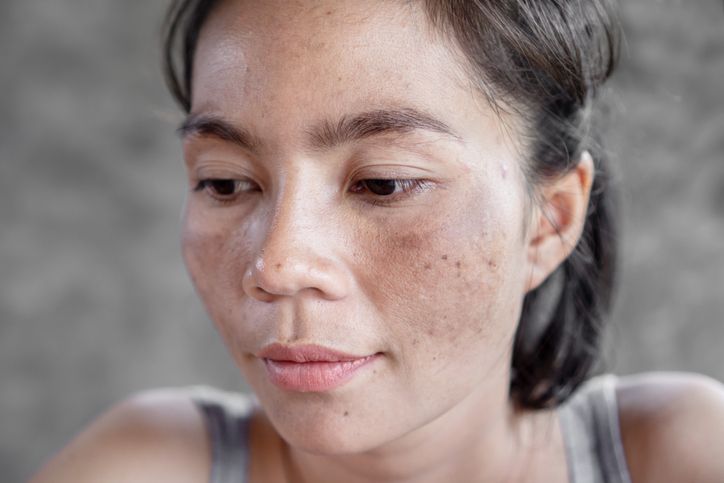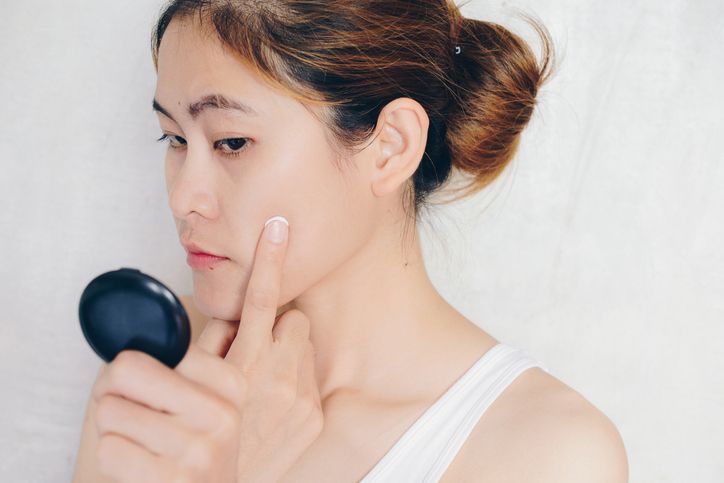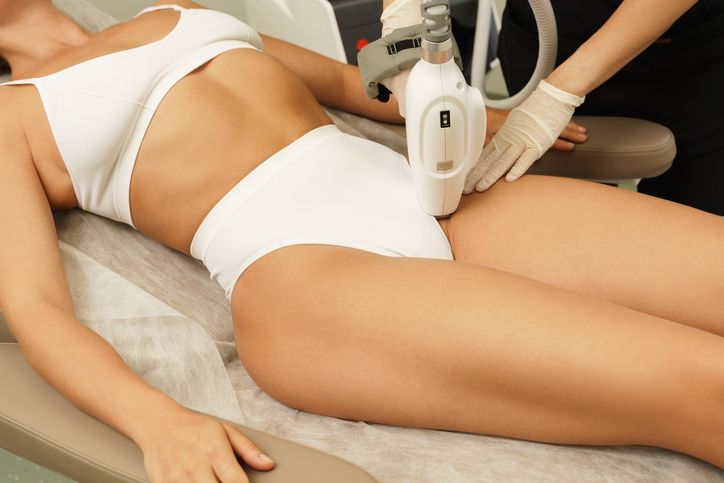- Home
- Trend
- Weight Loss Strategies
- Acne Tips
- Hair Health Information
- Blemish Removal Tips
- Acne Scar Removal Tips
- Muscle Building Techniques
- Intimate Care Tips
- Postpartum Intimate Care
- Eye Bags Wiki
- Tips for Face Slimming
- Secret of Permanent Hair Removal
- Breast Enlargement Tips
- Cure to Snoring
- Marionette Lines
- Skin-Tightening Secrets

免費體驗
PicoCure Pigmentation Removal Treatment
1 Minute Self-Registration
Date should not be before minimal date
Hyperpigmentation is a prevalent skin condition that affects a large number of people. It is characterised by the darkening or discoloration of specific areas of skin caused by an excess of melanin, the pigment responsible for skin colour. In this article, we will define hyperpigmentation and explain its relationship to enlarged pores, melanin accumulation, and sagging eyelids. We will also discuss available preventative measures and treatment options for effectively managing this condition.
1
What is Hyperpigmentation and What Causes Them?

Hyperpigmentation is when the skin makes too much melanin or builds up too much melanin in some spots. It can be caused by a number of things, such as light exposure, hormone fluctuations, ageing, or injuries to the skin. One of the main reasons for pigmentation is excessive sun exposure, as UV rays cause melanocytes to make more melanin.
Hyperpigmentation can also be caused by changes in hormones, such as those that happen during pregnancy or when taking certain medicines. This disease can also be caused by injuries to the skin, inflammation, and genetic tendency.
2
Common Types of Hyperpigmentation

Here are 4 types of common hyperpigmentation:
Melasma
This type of hyperpigmentation manifests as dark patches on the face. It is frequently caused by hormonal changes due to pregnancy or the use of birth control pills.
Post-inflammatory hyperpigmentation
This occurs after the skin has been hurt and inflamed via pimples, burns, or cuts. The resulting scars are dark in colours and rest on top of the healed wounds. The size of a pigmented lesion depends on that of the wound, and its texture varies.
Age spots
These small, dark spots are also called liver spots or solar lentigines. They usually show up on sun-exposed parts of the body, like the hands and face.
Freckles
Freckles are small, light brown spots that tend to run in families and get bigger when you spend time in the sun.
3
The Relationship Between Enlarged Pores and Hyperpigmentation

Enlarged pores are tiny holes on the skin's surface that are home to hair shafts and oil glands. There are many things that affect the size of pores, such as genes, skin type, and age. People with oily or combination skin tend to have bigger pores because their skin makes more sebum. Also, ageing and the lack of elasticity in the skin can make pores sag and look bigger.
By holding extra oil, dirt, and dead skin cells, enlarged pores can make hyperpigmentation worse. When pores get clogged, it can cause inflammation, which leads to post-inflammatory discoloration. In simple terms, the darkened skin on your face might stand out more if your pores are bigger.
Enlarged pores and hyperpigmentation are two distinct skin issues, but they can occasionally be connected or occur simultaneously. Let us investigate their relationship:
Increased sebum production
The production of excessive sebum by sebaceous glands can contribute to both enlarged pores and skin pigmentation. The excessive amount of oil can combine with dead skin cells and other impurities, resulting in clogged pores. These obstructed pores may enlarge and develop into blackheads or whiteheads. The inflammation caused by obstructed pores can increase melanin production, resulting in hyperpigmentation in the affected area.
Post-inflammatory hyperpigmentation
Post-inflammatory hyperpigmentation is often a result of acne caused by blocked pores, which are largely brought by excessive sebum. As part of the healing process, the epidermis which experiences the inflammation or trauma stimulates an increase in melanin production. This can result in hyperpigmentation or dark blotches on and around the affected area.
Sun exposure
Sun exposure can exacerbate both hyperpigmentation and enlarged pores. The sun's ultraviolet radiation damages the collagen and elastin fibres in the skin, resulting in a loss of skin elasticity and enlarged pores. Exposure to the sun also stimulates the production of melanin, resulting in increased pigmentation and the appearance of darker spots or regions.
4
How Does Melanin Accumulation Lead to Hyperpigmentation?

Melanin accumulation can result in hyperpigmentation via multiple mechanisms. Melanin is the pigment that gives our skin, hair, and eyes their colour. It is produced by melanocytes, which are specialised cells in the epidermis, the outermost layer of skin.
Hyperpigmentation happens when melanin builds up or is too much in some parts of the skin. This can be affected by a number of things, such as:
Ultraviolet (UV) exposure
The harmful uv rays can cause melanocytes to make more melanin for protecting the skin against sun damage. When you spend a lot of time in the sun or get a lot of sunburns, your body may make too much melanin. This can cause hyperpigmentation in localised areas, like sunspots or freckles.
Hormonal changes
Changes in hormone levels, like those that happen during pregnancy or as a result of hormone therapy, can trigger melanocytes into producing melanin excessively. This can cause skin diseases like melasma and chloasma, which are marked by dark patches on the face.
Inflammation and injury
Inflammation of the skin, commonly caused by acne, eczema, or psoriasis, can stimulate melanocytes into making more melanin. Cuts, burns, or scars on the skin can also boost melanin level as the skin heals. This is called post-inflammatory hyperpigmentation.
Genetic factors
Some people may be more likely to get discoloration because their genes make excess melanin more likely. Some genetic diseases, like lentigo or neurofibromatosis, can cause an abnormal amount of melanin to build up and make the skin darker than it should be. Some other gene variations can also cause the body to make more melanin or make it spread less evenly, which makes some people more likely to get dark spots or patches.
Family history plays a big role, as traits towards hyperpigmentation can be passed down from one generation to the next. Even though skin discoloration can be caused by genes, outdoor factors like sun exposure can make the problem worse.
In all of these situations, the skin gets darker patches, spots, or areas of hyperpigmentation because it makes or stores too much melanin. It's important to remember that the cause of hyperpigmentation can change the colour, shape, and size of the spots.

免費體驗
PicoCure Pigmentation Removal Treatment
1 Minute Self-Registration
Date should not be before minimal date
5
The Connection between Saggy Eye Areas and Hyperpigmentation

Loss of skin elasticity, which can be caused by factors like age, genetics, sun exposure, and lifestyle choices, is a common cause of sagging skin around the eyes. As we get older, our skin makes less collagen and elastin fibres, which makes the skin less tight and less able to stretch. This can make the skin around the eyes look like it's falling or sagging.
Hyperpigmentation can cause sagging skin around the eyes, which people often call "under-eye bags" or "dark circles." Collagen and elastin in the thin skin around the eyes tend to break down, resulting in puffiness and dark circles. In some cases, hyperpigmentation can make sagging eyelids stand out and look worse.
Several things can explain why sagging skin around the eyes is linked to hyperpigmentation:
Thin skin
When compared to other parts of the face, the skin around the eyes is usually thinner and more delicate. Thinner skin can cause sagging skin around the eyes and make blood vessels under the skin more visible, which can make dark rings or pigmentation appear.
Sun exposure
Too much sun can speed up the breakdown of collagen and elastic fibres, which can cause wrinkles and sagging skin around the eyes. Also, UV light can make your body make more melanin, which makes the darkening in this area stand out more.
Volume loss
As you get older, you lose fat and bulk in your face, including around your eyes. This loss of volume can make the skin around the eyes look saggy and can also make discolouration or dark circles stand out more.
inflammation
Increased melanin production and hyperpigmentation can be caused by skin conditions that cause inflammation or by rubbing your eyes often because of allergies or itching. Continuous rubbing or scratching of the eye area can also cause collagen and elastin fibres to break down, making the eye area look saggy.
Now that we have a clearer understanding of the relationships between hyperpigmentation with enlarged pores, melanin, and saggy eyelids. Let's go dive into the options on how to combat hyperpigmentation!
6
Ways to Overcome Hyperpigmentation

There are many ways to treat hyperpigmentation, both naturally and with the help of an expert. It's important to remember that how well these methods work depends on how bad the hyperpigmentation is and how each person's skin reacts. Here are the methods:
Natural treatments
1. Lemon juice Lemon juice has natural bleaching qualities as it is rich in vitamin C. You may be able to lighten hyperpigmentation by letting fresh lemon juice on the spots for a few minutes before washing it off. Beware that lemon juice can be irritating to some people, thus a patch test is necessary. You can also dilute the lemon juice with water if needed.
2. Aloe vera Aloe vera juice can heal and soothe the skin. Applying fresh aloe vera gel directly to the hyperpigmented areas and leaving it on for 30 minutes before washing it off to help the skin heal and lessen pigmentation.
3. Licorice Extract Glabridin, a chemical found in licorice extract, has been shown to stop melanin from being made. Look for skin care items with licorice extract or apply a paste made of licorice powder and water to the affected areas for 20 minutes before rinsing.
4. Turmeric Turmeric can help reduce inflammation and lighten the face. Mix turmeric powder with milk or honey to make a paste, then put it on the dark spots for 15 to 20 minutes before washing it off. Turmeric can briefly turn your skin yellow, so use it sparingly and wash it well afterward.
Professional treatments
1. Chemical peels Chemical peels are done by putting a chemical solution on the skin. This solution removes the top layers of skin and encourages the growth of new skin with even colour. Depending on how bad the hyperpigmentation is, different peels can be used, such as alpha-hydroxy acids (AHAs), beta-hydroxy acids (BHAs), or trichloroacetic acid (TCA) peels.
2. Photothermal/ Laser therapy Photothermal energy, such as intense pulsed light (IPL) or fractional lasers, can target and break down the skin's extra melanin. These treatments work by emitting controlled bursts of light or laser energy to the affected areas. This increases collagen production and gradually lightens hyperpigmentation.
3. Microneedling During microneedling, tiny holes are made in the skin with a derma roller, which stimulates your skin into making more collagen, giving your face a young and plump look. Microneedling can help reduce hyperpigmentation over time when used with serums or other treatments that are put on the skin.
In addition to natural and professional treatments, making certain lifestyle changes can help manage hyperpigmentation and promote overall skin health. Here are some lifestyle changes to consider:
Lifestyle changes
1. Sun protection Apply a broad-spectrum sunscreen with SPF 30 or higher to all exposed skin, even on cloudy days, and reapply them every two hours. Alongside that, seek shade during peak sun hours and wear protective clothing such as wide-brimmed hats, long sleeves, and sunglasses.
2. Gentle skincare routine You should use a gentle and non-irritating cleanser at least twice a day. While washing your face, you should avoid scrubbing or rubbing too roughly. Remember to pat your skin dry with a towel to avoid aggravating your skin. Besides that, you should search for skincare products that are non-comedogenic, mild, and appropriate for your skin type.
3. Stress management To deal with hyperpigmentation successfully, you should do things that help you feel less stressed. Regular exercise is important because it not only helps reduce stress but also improves blood flow, which is good for your skin and general health. Stress can also be reduced by practising relaxation methods like deep breathing, meditation, or yoga. Also, getting enough sleep is very important because it helps your skin cells renew and is good for your health as a whole. By using these tips, you can make your mind and body healthy, which will lead to better skin health.
4. Avoid picking or scratching Don't pick or scratch at your skin because it can make inflammation worse, cause post-inflammatory hyperpigmentation, and cause scars. Be gentle with your face and don't do anything that could hurt it.
5. Manage hormonal changes Changes in hormones can make discoloration worse, especially in cases like melasma. If you have hormonal issues, you should talk to a doctor or nurse who can give you advice on how to deal with them.
Managing hyperpigmentation is a slow process, and the results may be different for each person. It's important to be patient and consistent with your skin care practices and other lifestyle changes. There is, however, a treatment that can expedite the process of addressing hyperpigmentation without the need for lengthy skin care practices or natural remedies. A treatment by Perfect Medical called PicoCure Pigmentation Removal Treatment!
7
Restoring Your Youthful Radiance with Perfect Medical’s PicoCure Pigmentation Removal Treatment!

PicoCure Pigmentation Removal Treatment is a unique laser treatment utilising high-energy picosecond laser energy and nanosecond dual laser technology. The high laser energy can reach and destroy melanin, completely wiping off hyperpigmentation, skin discoloration, enlarged pores, age spots, sun spots, acne scars and more!
This new and advanced pigmentation removal treatment is non-invasive and painless. The pico laser technology combines with nano laser technology to achieve quick and long-lasting results. Once the nanosecond lasers reach the deepest layers of skin, they break up the melanin from big pigmented lesions into smaller pieces. Then, the pico lasers smash the pieces of melanin into tiny dust particles for the body to get rid of naturally. This pico laser treatment uses pico laser and nano laser energy waves of 4 different wavelengths to reach and remove skin discolorations of all depths and shades. The photothermal energy also smoothens and firms the skin's texture by increasing collagen formation.
Traditional single-wavelength laser treatments are much less powerful and versatile than PicoCure, which can brighten and smooth pigmented spots and the skin around them to perfection!
8
Conclusion

Prevent hyperpigmentation can be an easy job if you know its correct cause and treatments. Remember to protect your skin from the sun, stick to a skincare routine, and look for an effective treatment to fight against hyperpigmentation. Give Perfect Medical's PicoCure Pigmentation Removal Treatment a try and you will have healthier and more radiant skin!

免費體驗
PicoCure Pigmentation Removal Treatment
1 Minute Self-Registration
Date should not be before minimal date
FAQ

Can hyperpigmentation be completely cured?
Even though hyperpigmentation can be treated and made to look better, it may not be possible to get rid of it totally. Nonetheless, regular skincare habits and effective treatments can help make it less noticeable.
Are there any natural remedies for hyperpigmentation?
Some natural treatments, like lemon juice, aloe vera, and turmeric, are thought to brighten the face. Still, you should talk to a dermatologist before trying any home remedies, since they might not work for all skin types.
How long does it take to see results from hyperpigmentation treatments?
Treatments for hyperpigmentation can work differently depending on how bad the situation is and which method is used. To get the best results, it's important to set clear goals and stick to the treatment plan.
Can hyperpigmentation occur on any part of the body?
Yes, discoloration can appear on any part of the body. Face, hands, arms, and legs are common places where it happens.
Is hyperpigmentation a permanent condition?
Hyperpigmentation is a disease that can last for a long time, but with the right treatment and prevention, it can be greatly reduced. When dealing with discoloration, it's important to be consistent and patient.









